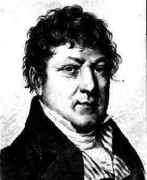◀ ▲ ▶History / 18th-century / Person: Delambre, Jean Baptiste Joseph
Person: Delambre, Jean Baptiste Joseph

Jean-Baptiste-Joseph Delambre was an astronomer who produced tables of the location of planets and their satellites. He also worked at the bureau of longitudes.
Mathematical Profile (Excerpt):
- The name Delambre is a form of "de Lambre" which probably comes from "lambeau" meaning "rag".
- There Delambre studied English and German but in 1764 the Jesuits were banned from France and at this stage he continued his education in Amiens, studying under teachers who had been brought from Paris.
- Up until this time Delambre had little reason to learn mathematics but now this changed.
- It was an ideal position for Delambre for he lived at in Geoffroy d'Assy's house and, choosing to accept far less in payment that d'Assy offered, he accepted a small pension and enjoyed living cheaply but learning all he could.
- He would change "de Lambre" to "Delambre" at the time of the Revolution to avoid its aristocratic appearance.
- Delambre's interests moved from the study of Greek and Greek literature to Greek science, and he read much on the topic.
- When Lalande was looking for a new assistant in 1783 to undertake observations for a new edition of his "Traité d'astronomie" Ⓣ(Treatise on astronomy), he turned to Delambre who was his best student.
- Lalande lent Delambre some equipment and the observational data he collected with it was incorporated into the third edition of Lalande's "Traité d'astronomie" Ⓣ(Treatise on astronomy) which would appear in print in 1792.
- In 1786 Delambre recorded a transit of Mercury across the Sun.
- Most astronomers gave up, but not Delambre who did not believe that the time predicted for the transit by Lalande was correct.
- When the cloud cleared forty minutes after the transit was predicted to end, Delambre was able to observe that the transit was still taking place.
- Delambre attended a meeting of the Académie des Sciences at which Lalande presented the data from the Mercury observations.
- Delambre was very impressed and decided to make observations of the orbit of Uranus in order to verify Laplace's theoretical results.
- When the Academy announced that the Grand Prix for 1789 would be for the calculation of the precise orbit of Uranus, Delambre had already done much of the work.
- By this time Delambre had his own observatory.
- In 1787 Geoffroy d'Assy moved into a new house in the le Marais district of Paris, west of the Bastille, and in 1788, encouraged by Lalande, he began building an observatory for Delambre above his bedroom on the top floor of the house.
- Delambre worked in his observatory and in 1792 he published "Tables du Soleil, de Jupiter, de Saturne, d'Uranus et des satellites de Jupiter" Ⓣ(Tables of the Sun, Jupiter, Saturn, Uranus and Jupiter's satellites).
- The principal landmarks in the development were the tables of Lacaille (1758), and the tables of Delambre that were published in the third edition of Lalande's "Astronomie" (1792), and the revised version of these tables published by the Bureau des Longitudes in 1806.
- In the same year of 1792 Delambre received the Grand Prix of the Académie des Sciences for the second time.
- Although Dominique Cassini was keen to take charge of the project, he refused to personally measure one sector and, on 5 May 1792 Delambre was given charge of the Dunkerque to Rodez sector and Méchain the Rodez to Barcelona sector.
- Delambre set out in June and began to seek triangulation points round Paris.
- Released after getting new official papers, Delambre was arrested again shortly afterwards since his instruments were thought to be suspicious and meant he was a spy.
- Delambre made comparatively little progress before returning to Paris for the winter, then set out the next spring to begin working his way south from Dunkerque.
- In May 1795 Delambre was reinstated and carried on the task he had been forced to end abruptly eighteen months earlier.
- Delambre made accurate baseline measurements in Melun, near Paris, in April 1798.
- An International Commission for Weights and Measures was set up and Delambre reported his results to it in February 1799.
- Details of the whole project were published by Delambre in "Base du système métrique" Ⓣ(The base of the metric system).
- Let us now look at some other landmarks in Delambre's career.
- Delambre attained further achievements in his career, however, including his appointment to the chair of astronomy at the Collège de France in Paris in 1807.
- The position had been held by Lalande until his death in that year and Delambre was proud to succeed his former teacher.
- The award went to Delambre for his work on the meridian.
- In the last part of his career Delambre became interested in the history of mathematics and astronomy.
- He published a two volume work "Histoire de l'astronomie ancienne" Ⓣ(History of ancient astronomy) in 1817, then Histoire de l'astronomie du moyen age Ⓣ(History of astronomy of the middle ages) in 1819, two volumes of Histoire de l'astronomie moderne Ⓣ(History of modern astronomy) in 1821, and his work on the history of astronomy in the eighteenth century was published by Claude Mathieu after Delambre's death.
- As one would expect, Delambre is especially good on astronomical tables and on methods of observation and calculation.
- Above all, Delambre spices his presentation with acerb and delightful comments ...
Born 19 September 1749, Amiens, France. Died 19 August 1822, Paris, France.
View full biography at MacTutor
Tags relevant for this person:
Ancient Greek, Astronomy, Geography, Physics
Thank you to the contributors under CC BY-SA 4.0! 

- Github:
-

- non-Github:
- @J-J-O'Connor
- @E-F-Robertson
References
Adapted from other CC BY-SA 4.0 Sources:
- O’Connor, John J; Robertson, Edmund F: MacTutor History of Mathematics Archive
